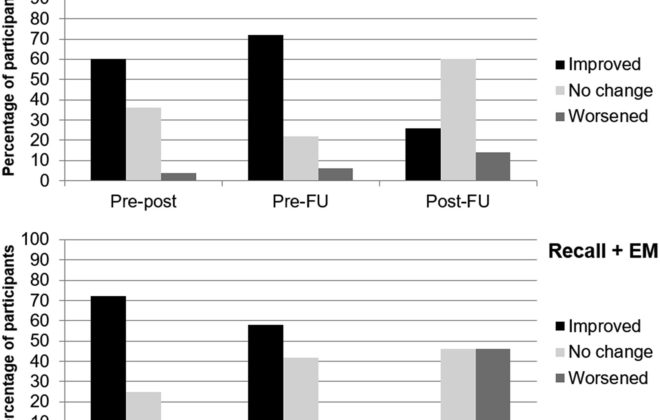Longitudinal Modeling
Typical for developmental psychology are models that capture change over time, such as latent growth (mixture) models and to a lesser extent cross-lagged panel models too. Such models have typically been applied aiming to capture change over time in individuals. Situations when to use longitudinal models include various testing moments of one’s post-traumatic stress score (Ter Heide et al, Thormar et al, Lommen et al, Mouthaan et al, Van Loey et al (a), Van Loey et al (b)), fatigue reduction after cancer (Wolvers et al), behavioral problems (Meeuws et al, Egberts et al, Basten et al, Bakker et al, Reijntjes et al (a), Reijntjes et al (b), Peeters et al, Van Zuiden et al, Bergsmann et al), guilt levels (Stroebe et al), and personality development (Peeters et al).
In a latent growth model, the time or measurement occasion variable is defined in the measurement model of the latent factors. To be more specific consecutive measurements are modeled by a latent variable for the intercept of the growth curve, and a second latent variable for the slope of the curve. With latent growth analysis, I refer to person-centred techniques to estimate individuals developing over time. Latent growth modelling assumes that all individuals are drawn from one population.
The development over time can be combined with a mixture component to estimate trajectory membership. Mixture modelling means that growth parameters (i.e., intercept, slope, etc.) vary across a number of pre-specified, unobserved subpopulations. These subpopulations are established through scores on one or more categorical latent variables. These additional variables allow for calculating growth trajectories per group. Hence, the usage of such variables results in separate latent growth models for each (unobserved) group, each with its unique set of growth parameters (for more detailed information, see Van de Schoot et al).
Because of the common usage of longitudinal models in developmental psychology, I have published on applying longitudinal models to empirical data and how to properly report on LGMM models, a specific type of longitudinal models.
Furthermore, I study the Bayesian counterpart of longitudinal models, and then particularly how the prior information can best be defined for small samples. Several of such papers are currently under review. Once these have been accepted, more information on them will be made available.
Ongoing
By means of this VIDI-project, I am developing my own research group on the usage with subjective priors for latent growth models with distal (long term) outcomes in the field of Bayesian statistics. The VIDI-grant is part of the innovational research incentives scheme of The Netherlands Organization for Scientific Research (NWO). The VIDI is the second (out of three) grants to develop their own research group.
In this project, background knowledge on trauma research is integrated within a statistical model assessing individual change over time and the existence of latent trajectories (Latent Growth Mixture Modeling, LGMM). Although many scholars have strong prior beliefs, the default LGMM-approach lets the data decide which model is to be preferred.
A posttraumatic stress disorder (PTSD) example
A ‘true’ delayed onset trajectory, as defined by DSM-IV, is characterized by initially the same symptom levels as a trajectory without PTSD, but is usually not found in studies. Maybe the ‘true’ delayed onset trajectory does not exist, maybe the exploratory LGGM is unable to trace it. The underlying issue is that the extraction of the correct number of latent trajectories is difficult in small data sets. Consequently, effects that are believed to exist in the population are probably not found in the data. In the current project, Bayesian statistics is being applied to statistically improve the LGMM-model. That is, I specify subjective priors based on an expert meeting in combination with a systematic review on a particular topic. The underlying assumption is that such information produces more useful results than an exploratory strategy could produce. This is especially the case when theoretical or research-based knowledge about the LGMM-model under investigation is available.
Coming soon
Completed
In this VENI-project background knowledge from trauma research is integrated in a statistical model that assesses individual change over time. Through specifying subjective priors in the Bayesian framework, I have argued that the evaluation of such specific prior beliefs produces more useful results than through conducting an exploratory strategy. The VENI is part of the innovational research incentives scheme of The Netherlands Organisation for Scientific Research. The VENI is the first (out of three) grants to develop their own line of research.
Sannes PhD focuses on the use of informative priors in latent growth models with small sample sizes. She is interested in how prior knowledge can be used to compensate for small sample sizes.
The analyses of two of the chapters of her PhD thesis are performed with Bayesian statistics in MPlus. Rens is copromotor (defence is March 3rd), thesis titled A coach in your pocket. On chronic cancer-related fatigue and...
In June 2012 I started my PhD project at the Helen Dowling Institute, which is a mental healthcare facility for cancer patients. There, I quantitatively investigated the effectiveness of two eHealth interventions for...
Inges research concerns the development of students with special educational needs due to psychiatric and/or behavior problems. Students with emotional and/or behavior problems (EBD) perform worse than normally developing students with respect to their academic and their ...





































